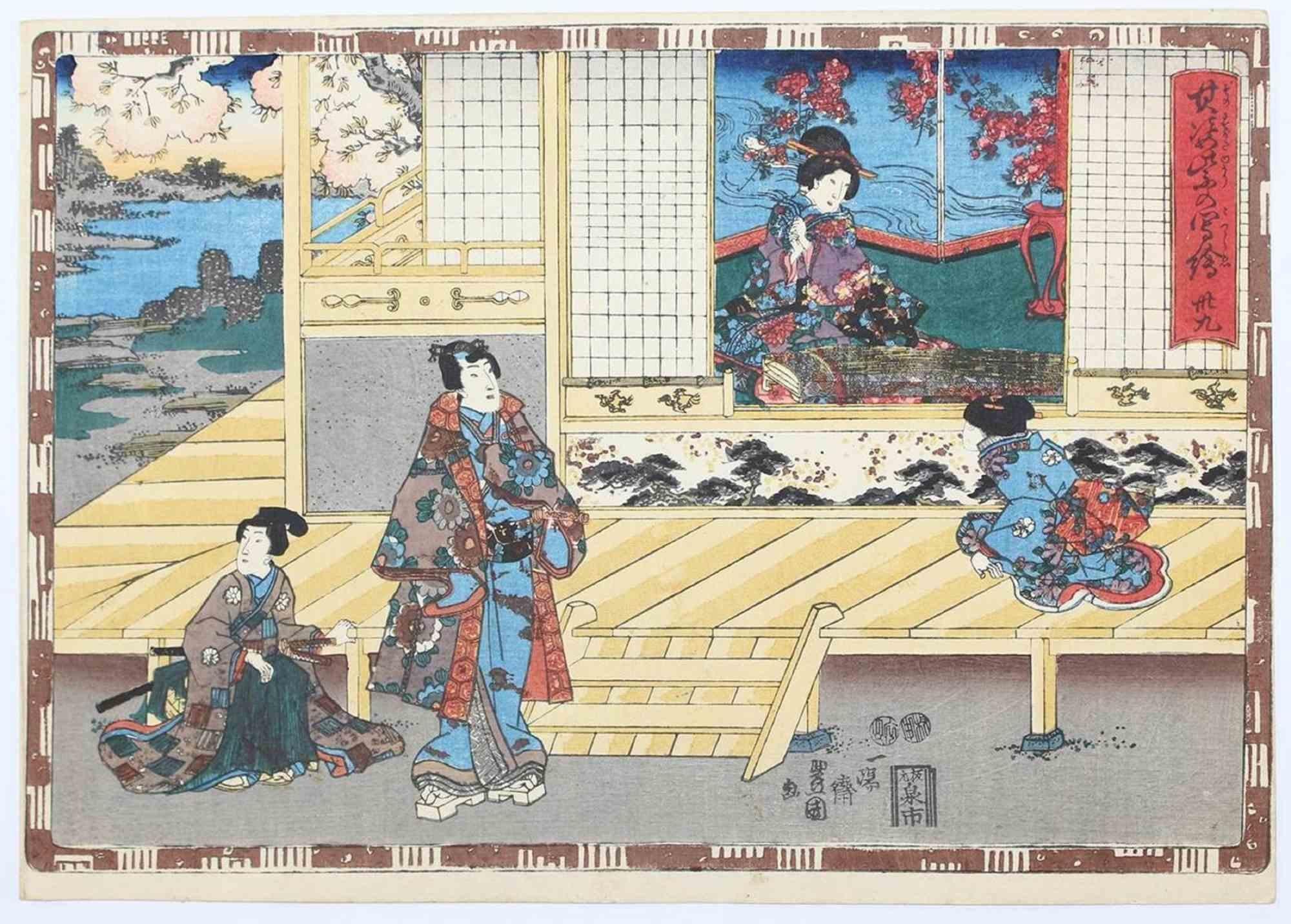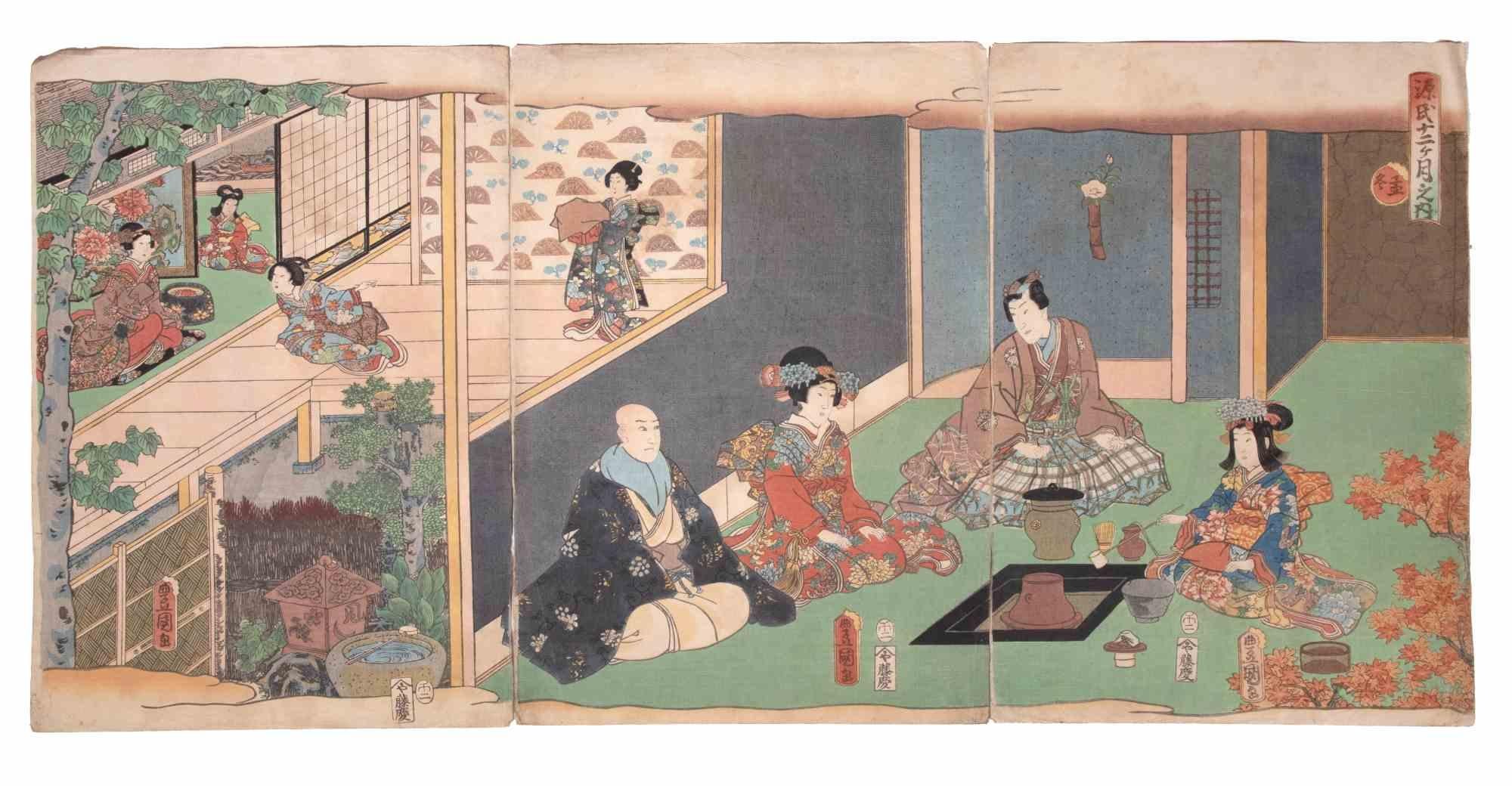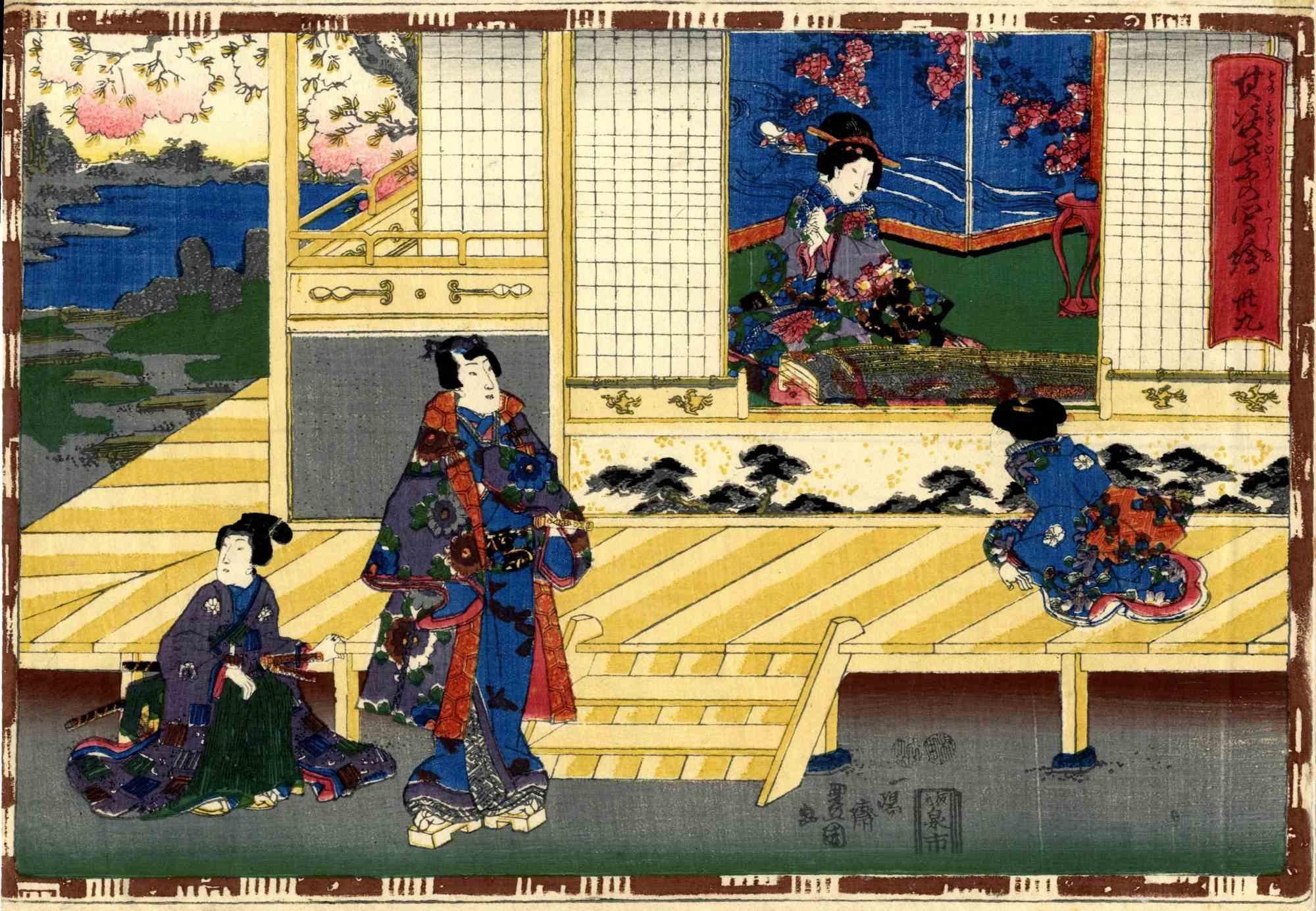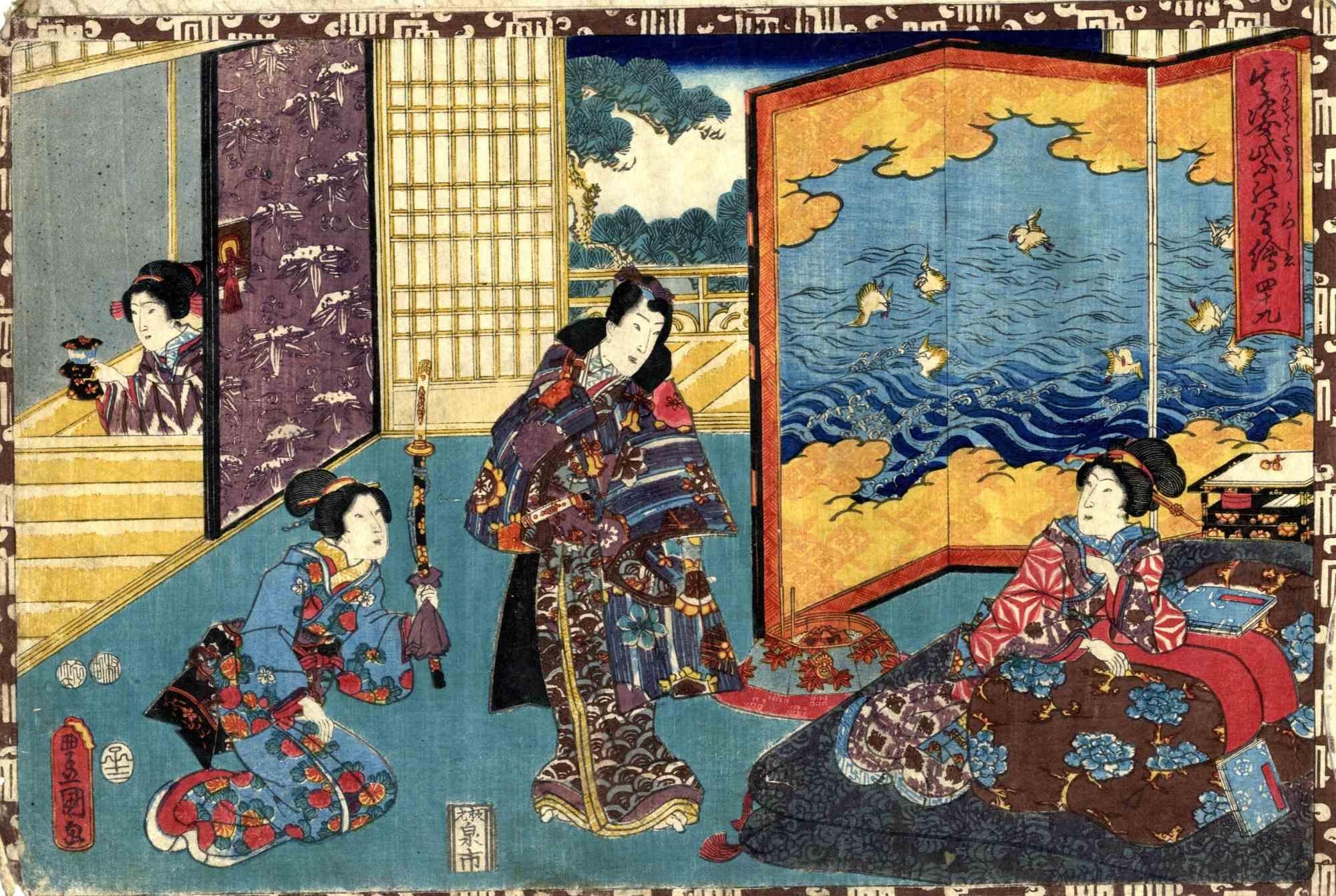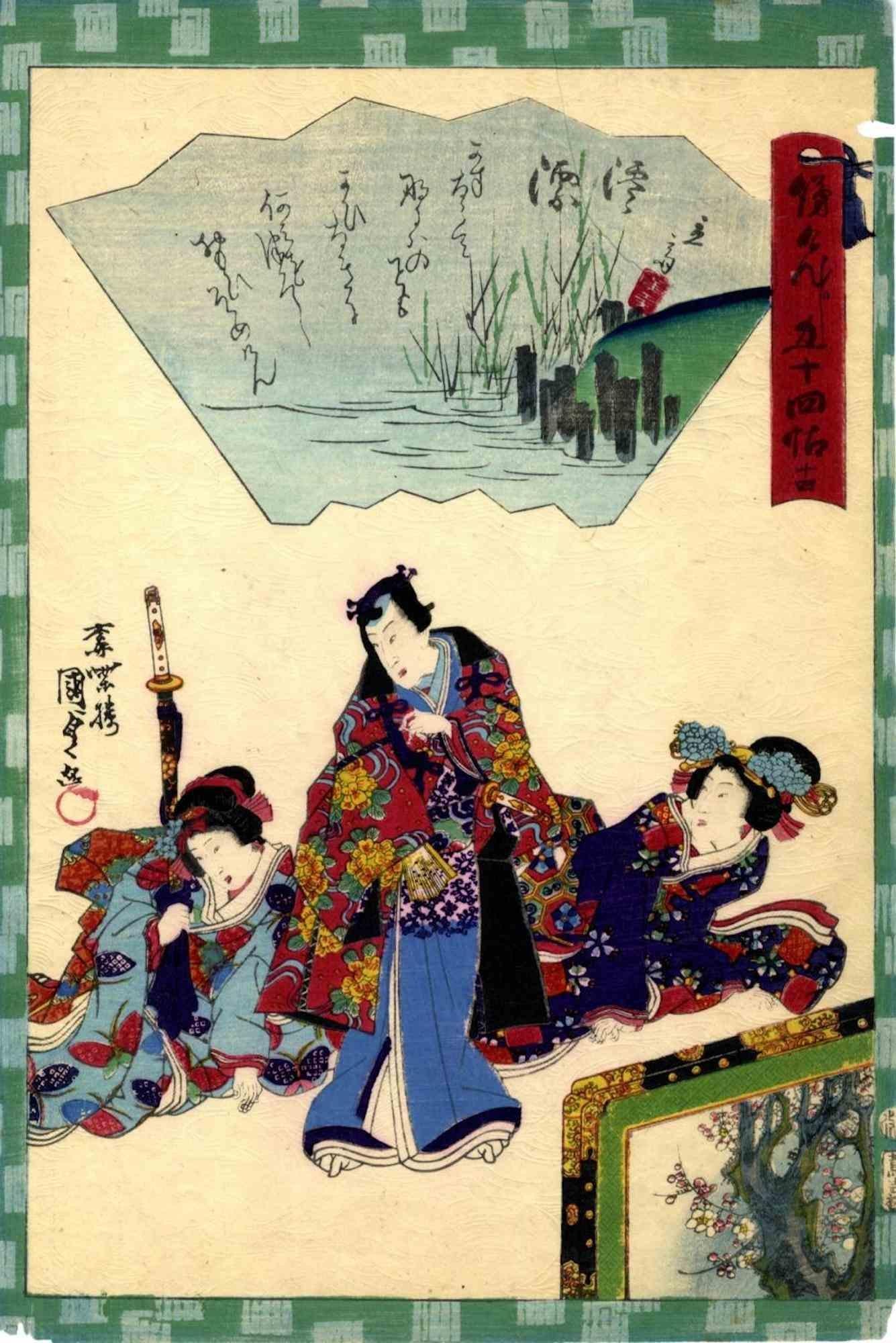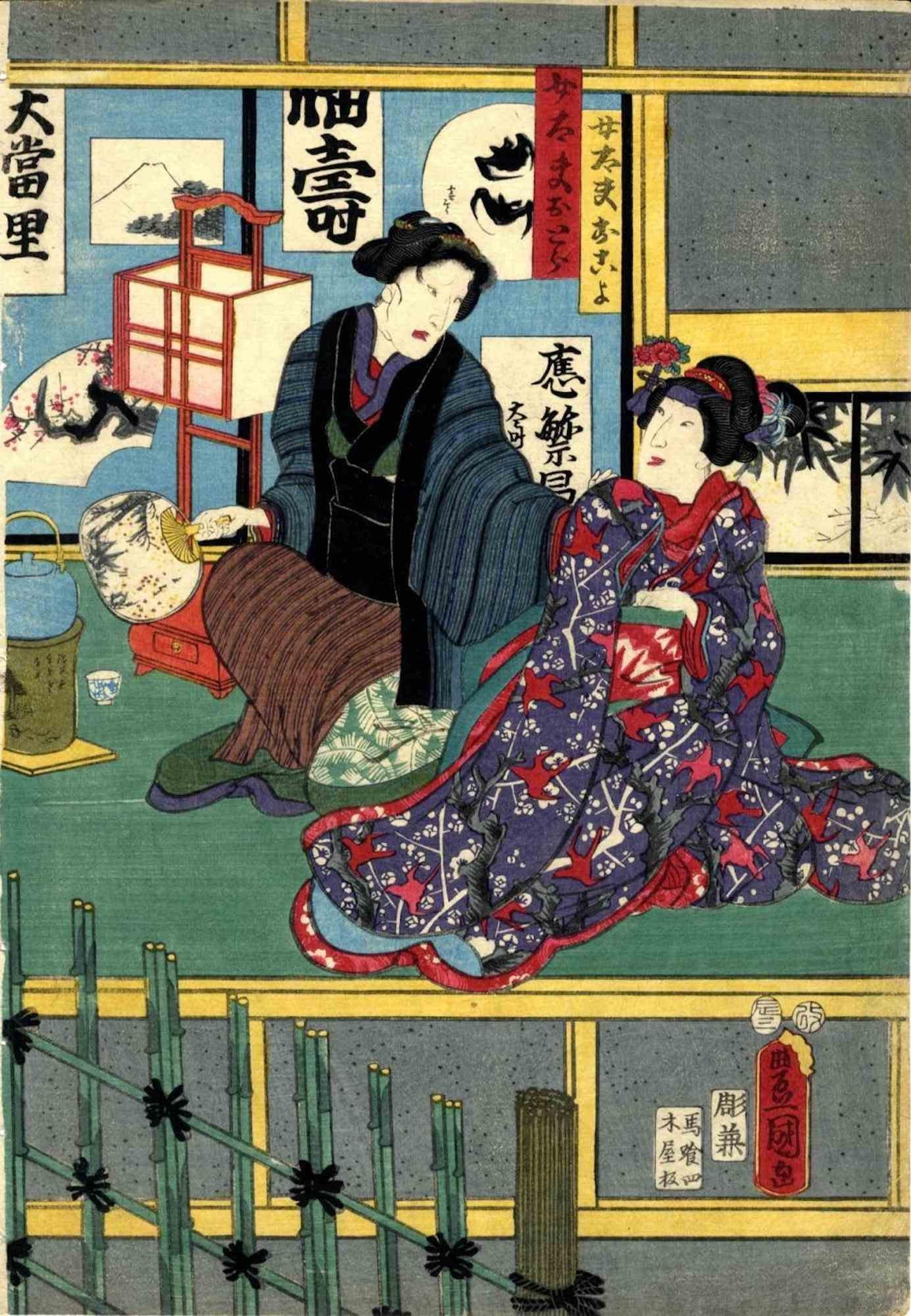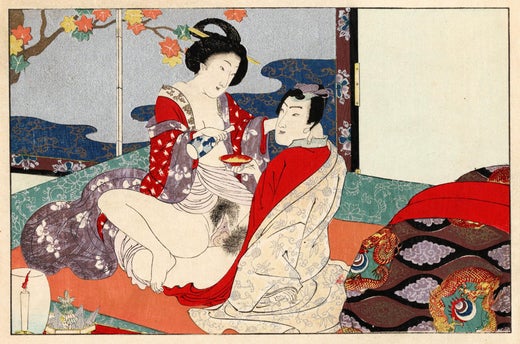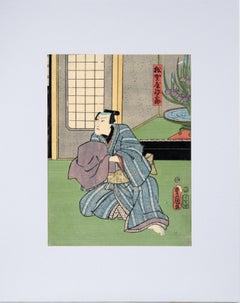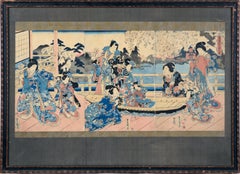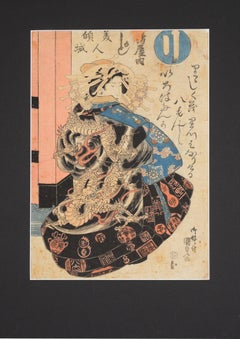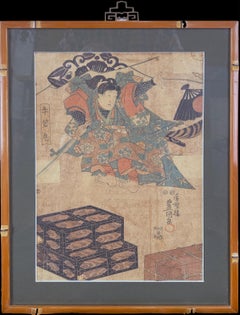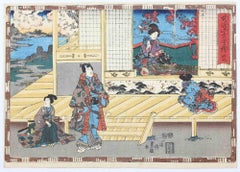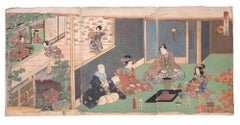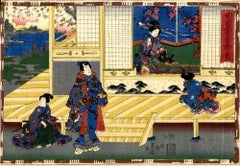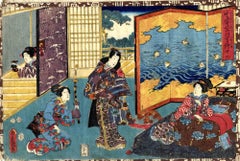Items Similar to Annual Events for Young Murasaki (July) - Tales of Genji - Japanese Woodblock
Want more images or videos?
Request additional images or videos from the seller
1 of 11
Utagawa Kunisada (Toyokuni III)Annual Events for Young Murasaki (July) - Tales of Genji - Japanese Woodblock1857
1857
$975
£735.25
€850.35
CA$1,367.92
A$1,520.53
CHF 797.03
MX$18,569.32
NOK 9,950.44
SEK 9,361.50
DKK 6,346.75
About the Item
Annual Events for Young Murasaki (July) - Tales of Genji - Japanese Woodblock
Rightmost panel a triptych, depicting monthly events for Wakamurasaki (Young Murasaki). This is the month of July. There appears to be a lesson taking place, possibly for writing or poetry.
Artist: Toyokuni III/Kunisada (1786 - 1864)
Publisher: Ebisu-ya Shoshichist
Presented in a new blue mat.
Mat size: 19"H x 13"W
Paper size: 14.5"H x 10"W
Commentary on the triptych:
In the Edo period, Tanabata was designated as one of the five seasonal festivals, and became an annual event for the imperial court, aristocrats, and samurai families, and gradually came to be celebrated by the general public. Its origins are said to be a combination of the Kikoden festival, which originated from the Chinese legend of Altair and the Weaver Girl, and Japan's ancient Tanabata women's faith. Ink is ground with dew that has accumulated on potato leaves, poems and wishes are written on five colored strips of paper, which are then hung on bamboo branches to celebrate the two stars that meet once a year. Although the illustration is a Genji painting, it depicts the preparations for Tanabata. In the upper left corner of the left illustration, a Kikoden festival desk can be seen, and five colored threads and a koto can be seen. Also, a wide lid held by the girl has a piece of paper in the shape of a koji leaf on it.
- Creator:Utagawa Kunisada (Toyokuni III) (1786-1864, Japanese)
- Creation Year:1857
- Dimensions:Height: 19 in (48.26 cm)Width: 13 in (33.02 cm)Depth: 0.25 in (6.35 mm)
- Medium:
- Movement & Style:
- Period:
- Condition:Condition is fair, has some age toning to paper as expected. Wrinkles at bottom edge. Mat is new.
- Gallery Location:Soquel, CA
- Reference Number:Seller: DBH97751stDibs: LU54215870142
Utagawa Kunisada (Toyokuni III)
Born in the Honjo district of Edo as Kunisada Tsunoda, Kunisada’s family owned a small hereditary ferryboat service. Though his father, an amateur poet, died when Kunisada was a child, the family business provided some financial security. During his childhood, he showed considerable promise in painting and drawing. Due to strong familial ties with literary and theatrical circles, he spent time studying actor portraits. At age 14, he was admitted to study under Toyokuni, head of the Utagawa school. Kunisada's work embodies the characteristics of the Utagawa school, focusing on traditional subjects such as kabuki, bijin (beautiful women), shunga (erotic prints), and historical prints. His first known print dates to 1807, his first illustrated book to 1808. Kunisada’s career took off from the beginning. Many of his works became overnight successes and he was considered the “star attraction†of the Utagawa school. He signed his works “Kunisada,†sometimes with the studio names of Gototei and Kochoro affixed. In 1844, he adopted the name of his teacher and became Toyokuni III. Kunisada passed away in 1864 in the same neighborhood that he was born. He was 70 years old. Kunis
About the Seller
5.0
Platinum Seller
Premium sellers with a 4.7+ rating and 24-hour response times
Established in 1986
1stDibs seller since 2014
2,985 sales on 1stDibs
Typical response time: <1 hour
- ShippingRetrieving quote...Shipping from: Soquel, CA
- Return Policy
Authenticity Guarantee
In the unlikely event there’s an issue with an item’s authenticity, contact us within 1 year for a full refund. DetailsMoney-Back Guarantee
If your item is not as described, is damaged in transit, or does not arrive, contact us within 7 days for a full refund. Details24-Hour Cancellation
You have a 24-hour grace period in which to reconsider your purchase, with no questions asked.Vetted Professional Sellers
Our world-class sellers must adhere to strict standards for service and quality, maintaining the integrity of our listings.Price-Match Guarantee
If you find that a seller listed the same item for a lower price elsewhere, we’ll match it.Trusted Global Delivery
Our best-in-class carrier network provides specialized shipping options worldwide, including custom delivery.More From This Seller
View All"Sun Saburo Matsugaya" - Mid 19th Century Figurative Japanese Woodblock Print
By Utagawa Kunisada (Toyokuni III)
Located in Soquel, CA
"Sun Saburo Matsugaya" - Mid 19th Century Figurative Japanese Woodblock Print
Beautiful mid 19th century figural Japanese woodblock print of a seated man with lilies in the background by Utagawa Toyokuni III (Kunisada) (Japanese, 1786-1864/5). Artist's chop is in the lower right corner of the piece. The actor is Magosaburo Matsugaya from the play "Katakiuchi Rumors"
Presented in a new grey-blue mat with foamcore backing.
Mat size: 21"H x 16"W
Paper size: 14"H x 9.75"W
During his lifetime Kunisada Utagawa...
Category
1850s Edo Figurative Prints
Materials
Paper, Ink, Woodcut
Elegant Amusements of Eastern Genji - Japanese Triptych Woodblock Print on Paper
By Utagawa Kunisada (Toyokuni III)
Located in Soquel, CA
Elegant Amusements of Eastern Genji - Japanese Triptych Woodblock Print on Paper
Dynamic woodblock print with several elegantly dressed figures by Utag...
Category
1850s Edo Figurative Prints
Materials
Paper, Ink, Woodcut
The Courtesan Kashiwagi and the Kamuro Wakano - Japanese Woodblock Print
By Utagawa Kunisada (Toyokuni III)
Located in Soquel, CA
The Courtesan Kashiwagi and the Kamuro Wakano - Japanese Woodblock Print
Original Toyokuni III/Kunisada (Japanese, 1786 - 1864) Japanese Woodblock Print
"The Courtesan Kashiwagi and...
Category
1820s Realist Figurative Prints
Materials
Printer's Ink, Rice Paper, Woodcut
Kumasaka Chōhan to Ushiwakamaru - One of a Diptych Original Woodcut Print
By Utagawa Kunisada (Toyokuni III)
Located in Soquel, CA
Kumasaka Chōhan to Ushiwakamaru is a Japanese Ukiyo-e print created between 1848 and 1854 by artist Utagawa Kunisada (Japanese, 1786-1864). The print is a Diptych, and is part of the...
Category
1850s Realist Figurative Prints
Materials
Printer's Ink, Rice Paper, Woodcut
"Juro Sukenari, Station #9: Oiso", Mid 19th Century Japanese Ukiyo-e Woodblock
By Utagawa Kunisada (Toyokuni III)
Located in Soquel, CA
Beautiful mid 19th century Japanese woodblock print of a samurai by Utagawa Toyokuni III (Kunisada) (Japanese, 1786-1864/5). This piece is from a series of "The 53 Stations of the To...
Category
1860s Edo Figurative Prints
Materials
Paper, Ink
"Various Himochi" Wagashi Festival Japanese Woodblock Print by Utagawa Toyokuni
By Utagawa Toyokuni
Located in Soquel, CA
"Various Himochi" Wagashi Festival Japanese Woodblock Print by Utagawa Toyokuni
Rare oversized early 19th century 5-tiered woodblock by Utagawa Ichiyosai Toyokuni, (Japan, 1769-1825), a Japanese lord and wife oversee a sekku festival of food, music, and dolls or toys. '"oshi" is the first day of “Mi (Snake)” in the third month of the lunar calendar. This day, known in modern Japan as the Girls' Festival, originated in China as a form of purification ceremony in which water and drinking peach blossom wine were used to drive away evil. Many kinds of hishi-mochi appear in this picture of hina ningyo (dolls associated with Hinamatsuri, or the Girl’s Day) from Omochae.
The custom of eating special dishes at events throughout the year and at milestones in people's lives has existed since ancient times. This paragraph specifically focuses on the annual event called sekku, and life events that involve eating sweets. Joshi is the first day of “Mi (Snake)” in the third month of the lunar calendar. This day, known in modern Japan as the Girls' Festival, originated in China as a form of purification ceremony in which water and drinking peach blossom wine were used to drive away evil. According to the Keiso saijiki, in ancient China, on the third day of the third lunar month, people ate “ryuzetsuhan,” which is the juice of gogyo (Jersey cudweed) mixed with rice flour and nectar. In Japan, there is a record in the Heian period history book Nihon Montoku tenno jitsuroku [839-5] that it was an annual event to make kusamochi using gogyo on the third day of the third month of the lunar calendar, which may have been influenced by Chinese customs.
The tradition of eating kusamochi on the third day of the third month of the lunar calendar continued after that. By the Edo period, however, hishimochi had come to be used as a sweet to serve on the third day of the third month. A picture of a hishimochi is included in the Morisada manko , which we mentioned in Part 1. According to it, hishimochi in the Edo period were often three layers of green-white-green instead of the now common red-white-green. However, it is possible to see from our collection that not all hishimochi were made in this way. Omochae published in 1857, is a good example. Omochae is a type of ukiyoe print...
Category
1820s Edo Figurative Prints
Materials
Ink, Rice Paper, Woodcut
You May Also Like
Yugiri - Woodcut by Utagawa Kunisada - 1850s
By Utagawa Kunisada (Toyokuni III)
Located in Roma, IT
Yugiri is an original artwork realized in the 1850s by Utagawa Kunisada (1786-1865).
Chapter 39 of the story Genji Monogatari. Color woodcut around 1851. Signed: Ichiyossai Toyokun...
Category
1850s Modern Figurative Prints
Materials
Woodcut
Genji in the Twelve Months - Woodcut by Utagawa Toyokuni III - 1858
By Utagawa Kunisada (Toyokuni III)
Located in Roma, IT
Genji in the Twelve Months / The Tenth Month (Moto) is a tryptich woodcut print realized by Utagawa Toyokuni III in 1858.
Very good condition except for some minor signs of wear.
Category
1850s Modern Figurative Prints
Materials
Woodcut
Genjie - Woodcut by Utagawa Kunisada - 1850
Located in Roma, IT
Genjie is an original artwork realized in 1850 by Utagawa Kunisada (1786-1865).
Oban yokoe.
From the series "Sono Sugata yukari no utsushi-e", 39th chapter.
Genji and his son Yug...
Category
1850s Modern Figurative Prints
Materials
Woodcut
Genjie - Woodcut by Utagawa Kunisada - 1852
By Utagawa Kunisada (Toyokuni III)
Located in Roma, IT
Genjie is an original artwork realized in 1852 by Utagawa Kunisada (1786-1865).
Oban yokoe.
From the series "Sono Sugata yukari no utsushi-e" (Faithful images of the Radiant Princ...
Category
1850s Modern Figurative Prints
Materials
Woodcut
Miotsukushi - Woodcut Print by Utagawa Kunisada II - 1864
Located in Roma, IT
Miotsukushi is an original modern artwork realized by Utagawa Kunisada and Hiroshige II in 1864
Woodcut Print Oban Format.
From the series "Omokage Genji gojuyo" (In reference to t...
Category
19th Century Modern Figurative Prints
Materials
Woodcut
Yakushae - Woodcut Print by Utagawa Kunisada - 1856
Located in Roma, IT
Yakushae is an original modern artwork realized by Utagawa Kunisada in 1856.
Woodcut print Oban from a tryptich.
An elderly lady has a worried conversation with a pretty young woma...
Category
19th Century Modern Figurative Prints
Materials
Woodcut
More Ways To Browse
Chinese Woodblock
Chinese Court Paintings
Samurai China
Antique Japanese Writing Desk
Antique Potato
Antique Chinese Rice Paper Paintings
Tale Of Genji
Kunisada Triptych
Japanese Koto
Utagawa Kunisada 1857
Silver Iron Bed
Swiss Made Wall Clock
Taureau Print
Vintage 70s Suitcase
Vintage Boy Scout
Vintage Chanel 1971
Vintage Cow Plates
Vintage Womens Hats 1940s Womens Hats
